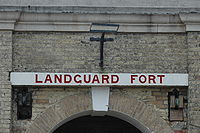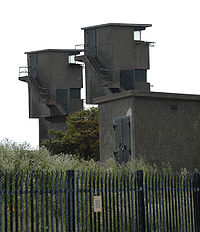
Landguard Fort
Encyclopedia

Felixstowe
Felixstowe is a seaside town on the North Sea coast of Suffolk, England. The town gives its name to the nearby Port of Felixstowe, which is the largest container port in the United Kingdom and is owned by Hutchinson Ports UK...
, Suffolk
Suffolk
Suffolk is a non-metropolitan county of historic origin in East Anglia, England. It has borders with Norfolk to the north, Cambridgeshire to the west and Essex to the south. The North Sea lies to the east...
, at the mouth of the River Orwell
River Orwell
The River Orwell flows through the county of Suffolk in England. Its source river, above the tidal limit at Stoke Bridge, is known as the River Gipping. It broadens into an estuary at Ipswich where the Ipswich dock has operated since the 7th century and then flows into the North Sea at Felixstowe...
, Landguard Fort was designed to guard the entrance to Harwich
Harwich
Harwich is a town in Essex, England and one of the Haven ports, located on the coast with the North Sea to the east. It is in the Tendring district. Nearby places include Felixstowe to the northeast, Ipswich to the northwest, Colchester to the southwest and Clacton-on-Sea to the south...
. The first fortifications from 1540 were a few earthworks and blockhouse
Blockhouse
In military science, a blockhouse is a small, isolated fort in the form of a single building. It serves as a defensive strong point against any enemy that does not possess siege equipment or, in modern times, artillery...
, but it was James I of England
James I of England
James VI and I was King of Scots as James VI from 24 July 1567 and King of England and Ireland as James I from the union of the English and Scottish crowns on 24 March 1603...
who ordered the construction of a square fort with bulwarks at each corner.

Netherlands
The Netherlands is a constituent country of the Kingdom of the Netherlands, located mainly in North-West Europe and with several islands in the Caribbean. Mainland Netherlands borders the North Sea to the north and west, Belgium to the south, and Germany to the east, and shares maritime borders...
landed a force of 1500 men on Felixstowe beach and advanced on the fort, but were repulsed by Nathaniel Darrell and his garrison of 400 musketeers of the Duke of York & Albany's Maritime Regiment (the first English Marines) and 100 artillerymen with 54 cannon. The fort was considered part of Essex
Essex
Essex is a ceremonial and non-metropolitan county in the East region of England, and one of the home counties. It is located to the northeast of Greater London. It borders with Cambridgeshire and Suffolk to the north, Hertfordshire to the west, Kent to the South and London to the south west...
in the 18th and 19th centuries; births and deaths within the garrison were recorded as 'Landguard Fort, Essex'.
A new Fort battery
Artillery battery
In military organizations, an artillery battery is a unit of guns, mortars, rockets or missiles so grouped in order to facilitate better battlefield communication and command and control, as well as to provide dispersion for its constituent gunnery crews and their systems...
was built in 1717, and a complete new fort on an adjoining site was started in 1745 to a pentagonal bastion
Bastion
A bastion, or a bulwark, is a structure projecting outward from the main enclosure of a fortification, situated in both corners of a straight wall , facilitating active defence against assaulting troops...
ed trace. New batteries were built in the 1750s and 1780, but the biggest change was in the 1870s where the interior barracks
Barracks
Barracks are specialised buildings for permanent military accommodation; the word may apply to separate housing blocks or to complete complexes. Their main object is to separate soldiers from the civilian population and reinforce discipline, training and esprit de corps. They were sometimes called...
were rebuilt to a keep-like design, the river frontage was rebuilt with a new casemated battery covered by a very unusual caponier
Caponier
A caponier is a type of fortification structure. The word originates from the French word "caponnière" - which strictly means capon-cote i.e. chickenhouse.The fire coming from the feature A caponier is a type of fortification structure. The word originates from the French word "caponnière" -...
with a quarter sphere bomb proof nose. Several open bastions were enclosed, and a mock ravelin
Ravelin
A ravelin is a triangular fortification or detached outwork, located in front of the innerworks of a fortress...
block constructed to house a submarine mining contingent.
During the Second World War
World War II
World War II, or the Second World War , was a global conflict lasting from 1939 to 1945, involving most of the world's nations—including all of the great powers—eventually forming two opposing military alliances: the Allies and the Axis...
, it was used as one of the balloon launch sites of Operation Outward
Operation Outward
Operation Outward was the name given to the British World War II program to attack Germany by means of free-flying balloons. It made use of cheap, simple gas balloons filled with hydrogen...
. This was a project to attack Germany
Germany
Germany , officially the Federal Republic of Germany , is a federal parliamentary republic in Europe. The country consists of 16 states while the capital and largest city is Berlin. Germany covers an area of 357,021 km2 and has a largely temperate seasonal climate...
by means of free-flying hydrogen balloons that carried incendiary devices or trailing steel wires (intended to damage power lines.) Between 1942 and 1944, many thousands of balloons were launched.
The 10inch gun pit in Left Battery was converted into a Anti-aircraft Operations Room for Harwich in 1939.
Visitors as well as local people, have their own experiences of paranormal activity in or around the Fort. The most common being the image of a sailor looking out of the top right window (the side visible from the road). Most reportings were in the 1990s, but occasionally there are still reports of lights at night and being "pushed" whilst visiting the top floors.
The fort has been structurally consolidated and is open every day from April to the end of October. It is now in the guardianship of English Heritage
English Heritage
English Heritage . is an executive non-departmental public body of the British Government sponsored by the Department for Culture, Media and Sport...
.

